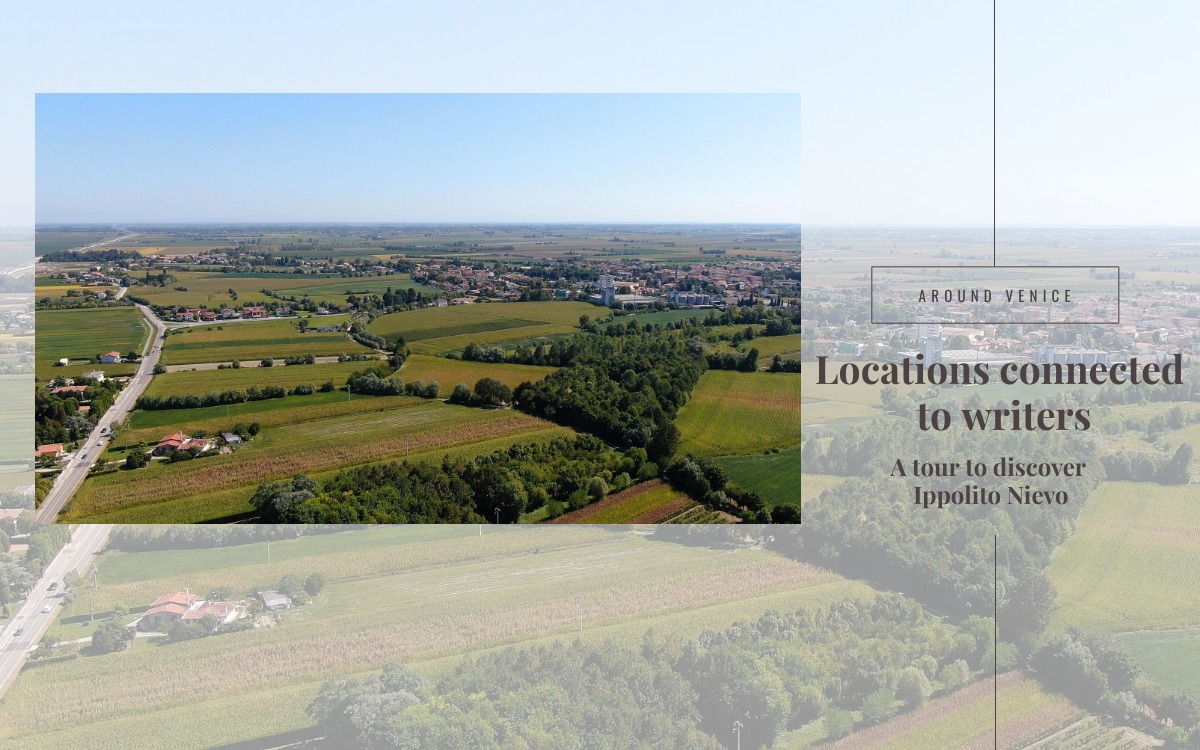Have you ever taken part in a guided tour through places associated with the life and works of an artist from the past?
This is an immersive journey capable of evoking the thoughts, sensations and significant moments of the famous figures that have marked Italy’s history.
We found it to be a unique experience and we want to tell you about it.
As guests of the TVO tourist agency and the ATVO public transport company, we discovered this tour dedicated to Ippolito Nievo and the places that inspired the writing of his novel “Confessions of an Italian“. Each stop has been marked by the stories of Sergio Frigo and by the passages of his guide “Writers’ Locations between Piave and Tagliamento“, published by Mazzanti Libri.
Ippolito Nievo and “Confessions of an Italian”
Born in Padua in 1831, Nievo spent his childhood in Udine and then in various cities of the Lombard-Veneto Kingdom. These places then went on to provide the backdrop to his works, whose characters move between Lombardy, Veneto and Friuli.
In 1860 he embarked on the Expedition of the Thousand and, after the conquest of the Kingdom of the Two Sicilies, he was commissioned to bring back some administrative documents to the north: the steamship Ercole on which he set sail sank in mysterious circumstances, leaving no trace of either it or its passengers.
“Confessions of an Italian” is the only novel by Nievo and was published posthumously. It is decidedly one of the most important works of the Italian Risorgimento: set between 1700 and the uprisings of 1848, it recounts the events of Carlo Altoviti, a patriot now in his 80s who experienced his identity transform from Venetian to Italian, intertwining his story with the events of the Risorgimento.
First stop: Portogruaro
The tour following in the footsteps of this important text begins in Portogruaro, the setting of the opening chapters of Confessions.
Extending across the banks of the Lemene river with its flower-covered bridges and characteristic mills, Portogruaro is a city that really deserves to be discovered. It is called “The little Venice” of eastern Veneto and Nievo himself wrote that “only the water was missing to complete its resemblance to Venice“.
Being positioned on the border between Veneto and Friuli Venezia Giulia, it was an important gateway to Austria for Venice: this is why for a long time it was the direct end point of the trade, ideas and customs established in Venice, clearly differentiating itself from the surrounding countryside.
Not to be missed: the Villa Comunale, a typical example of a Venetian villa, the Palazzo Vescovile and the Sant’Andrea Mills.
Second stop: Fratta di Portogruaro
We went on to Fratta, a district of Fossalta di Portogruaro, since it is home to Cortino, which represents a central place in Nievo’s work. The young Ippolito knew these places very well because he would visit his uncles in Teglio Veneto, not far from here.
In this location, Nievo placed the Castle at the centre of the events of Confessions, for which he was probably inspired by the castle of Colloredo di Monte Albano, home of the maternal family. In fact, a castle had also existed in Fratta, which was demolished at the end of the eighteenth century, and Nievo knew its ruins.
The remains of the castle of Fratta now include the rural house called “Cortino” which houses the Nievo Museum and a reconstruction of the castle kitchen, which are absolutely worth a visit.
A park has also been created around the building with an open-air theatre, a garden and an orchard with ancient tree and flower species. Here, in the Garden of Mars and Flora, you can admire an unusual labyrinth that highlights the structure of the no-longer existent building.
Third stop: Cordovado
Named one of the most beautiful villages in Italy in 2005, Cordovado was our third stop following in the path of Nievo: it was here the author set the love stories of Leopardo and Doretta, Lucilio and Clara, and the more novel-esque tales of Brutus Provedoni and Spaccafumo, the town baker.
Not to be missed: the ancient Pieve di Sant’Andrea, Piazza Nievo, the walls and the historic centre where the Castle is located are an absolute must-visit.
There are two other stops in this area where you can find and understand Nievo’s words: the first is the Fountain of Venchiaredo, “a large and clear fountain with cooling and healthy qualities” in the municipality of Sesto al Reghena. Here Nievo sparked the love between the impetuous and naive Leonardo Provedoni and the charming daughter of the Chancellor of Venchieredo, Doretta, and this same spring is said to also have inspired Pier Paolo Pasolini’s sonnet “Limpida fontana”.
The second stop is the Stalis Mills in Gruaro, which have recently been restored and opened to visitors. Located on the banks and on an island in the middle of the Lemene river, right on the border between Veneto and Friuli Venezia Giulia, they offer evocative views. Here two protagonists of Confessions, the doctor Lucilio and the countess Clara, reveal their mutual love but are surprised far from the castle of Fratta just as it is besieged by a popular uproar stirred up by the lord of Venchieredo.
Visiting these places accompanied by the words of an author such as Ippolito Nievo was a truly unique experience. It is an innovative and interesting format that we recommend you try out by indulging in a pleasant day in good company.
Ready to hit the road? Find out how to take part and request information on the tour by visiting the official TVO website.





Love this.
I am looking for the exact location of that magic vista, described in chapter three, supposedly the historical site of an Attila’s camp, close to the Lugugnana sea coast, where Carlito first time sets eyes on the Mediterranean Sea. Can you help me there?